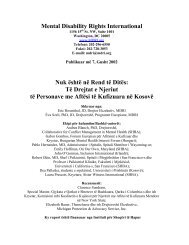Torture not Treatment - Disability Rights International
Torture not Treatment - Disability Rights International
Torture not Treatment - Disability Rights International
You also want an ePaper? Increase the reach of your titles
YUMPU automatically turns print PDFs into web optimized ePapers that Google loves.
TORTURE NOT TREATMENT<br />
emotionally disabled and have the cognitive ability to understand what lies ahead, JRC‘s website<br />
is explicit that the threat of electric shock is enough to bring about the end of negative<br />
behaviors. 150<br />
The most widely overlooked prong of the definition of torture is discrimination. Even if the<br />
purpose of a practice were otherwise considered legitimate, the infliction of pain based on<br />
disability can<strong>not</strong> be justified. As Nowak has stated, ―the requirement of intent in article 1 of the<br />
Convention against <strong>Torture</strong> can be effectively implied where a person has been discriminated<br />
against on the basis of disability.‖ 151<br />
The use of electric shock or long-term restraint is never tolerated on individuals without<br />
disabilities. The New York Psychological Association Task Force points out, for example, that<br />
New York‘s proposed regulation ―for disabled students would constitute corporal punishment if<br />
employed as interventions for non-disabled students….The implications of regulations that<br />
selectively permit the use of corporal punishment with disabled youth but <strong>not</strong> nondisabled youth<br />
are both obvious and disturbing, regardless of whether one calls it ‗corporal punishment‘ or<br />
‗aversive behavioral intervention.‘‖ 152<br />
The New York Psychological Association Task Force also says that ―[d]isturbingly, some of the<br />
‗techniques‘ listed…sound eerily similar to recent reports about methods for interrogation of<br />
suspected terrorists that have been labeled as ‗torture‘ and widely condemned by human rights<br />
organizations.‖ 153 This point is strongly reinforced upon closer examination to similar practices<br />
widely understood to constitute torture or ill-treatment. What is being justified as beneficial<br />
―treatment‖ for people with disabilities is widely understood to be psychologically damaging<br />
when perpetrated against non-disabled individuals.<br />
The infliction of electric shock is widely understood to constitute torture in any other context and<br />
they are understood to be extremely damaging to the individual. In 1997, Amnesty <strong>International</strong><br />
did an exhaustive report on electro-shock torture used around the world against people in custody<br />
by law enforcement officials, governments and military forces. It described the use of stun guns,<br />
tasers, cattle prods, stun batons and remote controlled stun belts, documenting electric-shock<br />
torture and ill treatment in 50 countries as torture. As these practices are described:<br />
…Electro-shock weapons have been deliberately, and often repeatedly, applied to<br />
sensitive parts of prisoners‘ bodies, including their armpits, necks, faces, chests,<br />
abdomens, the inside parts of their legs, the soles of their feet…Depending on the<br />
application and the individual, immediate effects include severe pain, loss of muscle<br />
control, nauseous feelings, convulsions, fainting and involuntary defecation and<br />
urination. Long term effects from electric shock torture can reportedly include<br />
muscle stiffness, impotence, damage to teeth, scarring of skin, hair loss, post<br />
27




